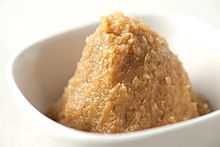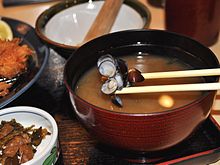Miso soup
[6] When the ingredients involve clams such as asari, shijimi, or hamaguri, they will impart flavorings that serve the role of dashi and thus it is not necessary to prepare any stock in advance.
Ingredients may include mushrooms (nameko or shiitake), potato, taro, seaweed, green laver, onion, nira, common bean, mitsuba, shrimp, fish, clams, and sliced daikon.
Hearty and robust cold-weather variations may include daikon, deep-fried tofu called abura-age, potatoes, onions and dark miso.
Japanese recipes usually call for most vegetables to be cooked in the simmering dashi, particularly mushrooms, daikon, carrots, potatoes, tofu, and fish.
In Japan, miso soup and white rice make up the central dishes of the traditional Japanese breakfast.
It generally contains dried toppings such as wakame and tofu with soybeans that reconstitute rapidly on the addition of hot water.
[8] These are popular in the Japanese workplace, where miso soup can be made with lunch as easily as green tea and using the same water.
[10] Studies in 2020 showed that habitual consumption of miso soup has the effect of lowering blood pressure and heart rate,[11] causing proliferation of good bacteria in the intestines and helping to prevent constipation.
[12] A 2003 epidemiology study in Japan discovered that persons who consume miso soup daily have a lower risk of stomach cancer and heart disease.
In 2019 research concluded that fermented soy foods, such as miso, have antidiabetic, antioxidant (anti aging), anti-obesity, anti‐inflammatory, anticancer and antihypertensive (lowering blood pressure) properties.





